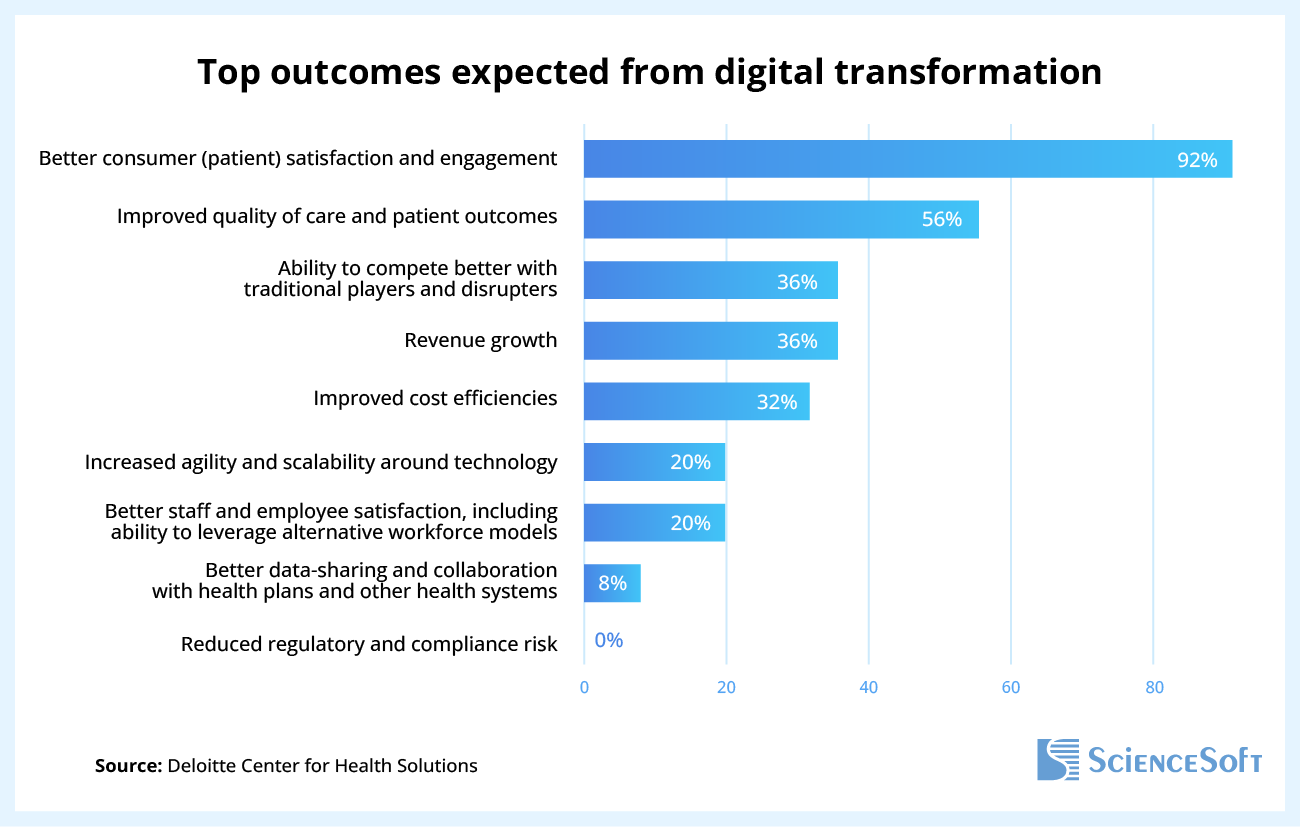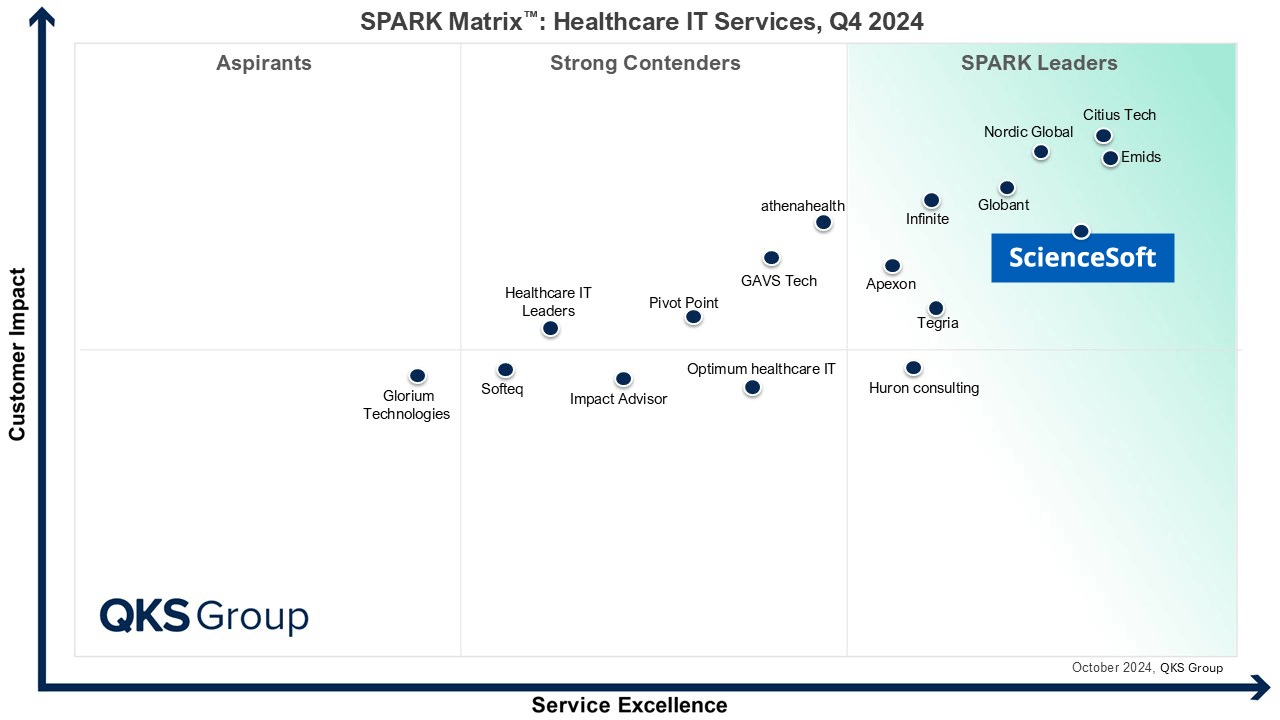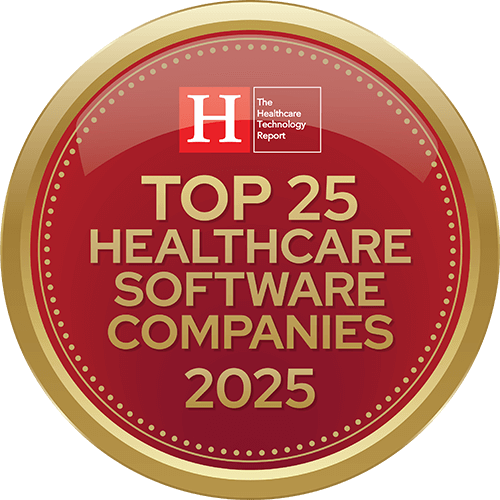Digital Transformation in Healthcare
Market Overview, Solutions, Roadmap, and Costs
Since 2005, ScienceSoft has been helping healthcare providers reduce care delivery costs and improve patient outcomes with specialized IT solutions. We design and implement successful digital transformation strategies even amidst diverse expectations of medical staff, shifting priorities, and resistance to change.
Digital Transformation in Healthcare: Summary
Digital transformation in healthcare refers to the use of digital technology to enhance clinical and administrative processes within a healthcare organization. It can be aimed at reducing care delivery costs, and improving patient outcomes.
Digital healthcare innovation may include a range of initiatives. For example, to reduce care costs and increase operational efficiency, a hospital can implement RFID-based systems for accurate real-time tracking of medical supplies and equipment or migrate legacy software (such as EHR, LIS, and RIS) to the cloud, making it more efficient and less costly to maintain.
Key healthcare digital transformation steps
- Analysis of the clinical and administrative workflows, along with the relevant medical staff and patient pain points.
- Designing a strategy for digital innovation in healthcare with a focus on measurable outcomes, sustainability, PHI security, and long-term cost control.
- Defining a clear project plan that outlines project deliverables, timelines, budget, critical milestones - along with risk mitigation strategies for each initiative - to support gradual implementation that prevents care disruptions.
- Development, testing, and implementation of new solutions, including their integration with internal and third-party systems.
- Training the administrative or clinical staff who will use the new systems.
Timelines: 12–30 months on average.
Cost: $250,000–$5,000,000+, depending on the complexity of the digital transformation project.
Team: a digital transformation consultant, a project manager, a compliance consultant, a system architect, a DevOps engineer, UX and UI designers, front-end and back-end developers, data scientists, QA engineers.
As a digital transformation partner, ScienceSoft can design a healthcare digitalization strategy, handle the transformation of your clinical or administrative processes end to end, or implement targeted changes to apps and IT infrastructure to address granular challenges.
Digital Transformation Pace in Healthcare
Although, according to the report by the World Economic Forum, healthcare continues to lag behind some other industries in terms of digital maturity, nearly 90% of health system executives surveyed consider digital transformation a high or top priority for their organization. At the same time, 75% of them admit that they do not have enough funds or planning capabilities to implement all their desired digital transformation initiatives, says McKinsey.
According to the research by the Deloitte Center for Health Solutions, 92% of technology executives surveyed expect to achieve better patient satisfaction and engagement from their digital transformation initiatives, with improved quality of care being the second most expected outcome (56%). Among the top healthcare functions receiving the most digital investments are patient experience (88%), IT/cybersecurity (80%), and clinical care delivery (68%).

Digital transformation strategies in healthcare must focus on the big picture, as all healthcare processes are deeply interconnected. You cannot make isolated changes in one area without affecting other clinical and administrative workflows. For example, if you start offering virtual consultations via a telemedicine app, your appointment scheduling process will need to adapt as well. Your scheduling software will need to differentiate between appointment types, enable providers to toggle availability for each type, and ensure time blocks are allocated appropriately, including time for pre-visit tech checks or post-visit documentation. That’s why, when estimating digital transformation initiatives, we consider not just the TCO for a single system but also the downstream changes it will trigger. In healthcare, those ripple effects might easily add up to millions of dollars.
Solutions for Digital Transformation in Healthcare
Explore the examples of the solutions that are commonly implemented as part of digital transformation in the healthcare industry and study the technologies that support it.
Care management and administrative software
See all
Patient engagement and monitoring tools
Advanced Technologies for Digital Transformation in Healthcare
Roadmap to Digital Transformation in Healthcare
Below, ScienceSoft's consultants share a sample digital transformation roadmap to give healthcare providers a general idea of how to plan and implement this strategic change while deriving the greatest benefits from it.
1.
Analysis of the existing clinical and administrative workflows
ScienceSoft starts any healthcare transformation project with an in-depth analysis of the following aspects:
- A healthcare provider's overall business situation, goals, and needs.
- Current clinical and administrative processes, relevant KPIs, challenges, and improvement opportunities.
- IT infrastructure and existing software of a healthcare provider, their constraints and transformation potential.
- Regulatory compliance requirements, e.g., HIPAA and the 21st Century Cures Act in the US or GDPR in the EU.
2.
Designing a digital transformation strategy
At ScienceSoft, this stage covers:
- Determining long-term digital transformation goals and prioritizing them based on the costs and the expected measurable value. For instance, the goal could be improving patient outcomes, and the expected value could be reducing readmission rates by 10%.
- Dividing long-term digital transformation goals into clear short-term objectives and determining a set of time-framed initiatives to achieve these objectives. For example, achieving a long-term hospital digital transformation goal of improved patient outcomes may involve such objectives as enhancing diagnostic accuracy or increasing patient access to healthcare services. The corresponding initiatives may include implementing AI-powered medical diagnosis software or a telemedicine app.
- Introducing a step-by-step action plan for the project of digitization in healthcare, which may include:
- Planning the required modernization of the existing IT infrastructure (cloud migration, IT infrastructure automation, implementation of advanced cybersecurity tools, etc.) and evolution of legacy software (rearchitecting, code refactoring, tech stack modernization, implementation of new functional modules).
- Preparing a feature set for the new healthcare software, including capabilities powered by advanced techs (AI, IoMT, big data, etc.).
- Designing a secure, scalable, high-performing architecture for new healthcare software.
- Creating a plan of integrations with existing software (e.g., EHR, CRM, HIE, LIS, RIS, RCM), external services and tools (user authentication services, etc.), and third-party systems (e.g., health insurers’ systems). Specifying data exchange standards (FHIR, USCDI, HL7 v2, CCDA, XDS/XDS-I, where required).
- Designing role-specific UX and UI (e.g., for doctors, administrative staff, and patients) for new healthcare applications. Designers must consider the unique needs of each role, such as quick access to patient history for physicians, streamlined scheduling tools for administrative staff, and intuitive appointment booking for patients. Designers also focus on making the solutions accessible for users with visual, auditory, or cognitive impairments. For example, they ensure the solution’s compatibility with screen readers and implement other accessibility features required by WCAG.
- Selecting the best-fitting tech stack to implement the project.
- (optional) Developing a proof of concept (PoC) to assess the viability of innovative healthcare software (e.g., for AI-powered healthcare solutions).
When an organization’s needs can be effectively addressed with low-code solutions, we opt to use them to reduce digital transformation costs and secure an early pay-off. Low-code platforms can bring up to a 70% reduction in development costs compared to custom software engineering. For example, we can use HIPAA- and GDPR-compliant Microsoft Power Apps to build internal web and mobile apps for doctors and administrative staff or web portals (e.g., patient portals). Typically, such apps are suited for low-code development as they rely on standard user interfaces and require minimal custom coding. Such an approach also allows us to integrate them easily with other Microsoft platforms like Microsoft 365 or SharePoint.
3.
Digital transformation project planning
At this stage, ScienceSoft delivers a detailed project plan that comprises:
- Project deliverables, timelines, budget, and ROI estimates at the level of the entire project and each particular transformation initiative.
- Critical milestones, objectives, and KPIs for each transformation initiative.
- The project team and collaboration workflows.
- Short-term and long-term transformation plans for gradual implementation of digital transformation initiatives and training of medical and administrative staff.
- A risk mitigation strategy and plan.
4.
Step-by-step implementation of healthcare digital transformation initiatives
At this stage, ScienceSoft's team implements the planned digital transformation initiatives. The key implementation steps may comprise the following:
- IT infrastructure modernization, including migration to the cloud (e.g., to Microsoft Cloud for Healthcare or other HIPAA-compliant clouds) and a tech stack revamp of legacy healthcare software.
- Custom healthcare software development. Developers apply best practices for reducing development costs, such as using ready-made components and services from reputable cloud providers (e.g., Azure, Amazon, Google Cloud) and introducing DevOps practices.
- Quality assurance of healthcare software (covering functional, usability, and performance tests) typically runs in parallel with development to catch defects early and prevent them from slipping into final software builds.
- Security and compliance testing of healthcare software and its infrastructure (including HIPAA compliance testing).
- Integration with relevant internal (e.g., EHR, LIS, RIS) and third-party systems (e.g., systems of long-term care facilities or insurers’ systems) using standard exchange models (FHIR, USCDI, HL7 v2) and enabling consistent clinical and billing coding (SNOMED CT, LOINC, RxNorm, ICD-10, CPT, HIPAA X12 837/835, eCQMs/QRDA, NCPDP SCRIPT as in scope).
- Implementing advanced healthcare data analytics to monitor and forecast operational and financial metrics, track health outcomes, or provide clinical decision support for the medical staff.
- Data migration from the previously used healthcare tools.
- Automated deployment of healthcare software to the production environment.
5.
Knowledge transfer and training for the administrative or clinical staff
To ensure smooth knowledge transfer and fast adoption of the new system among medical and administrative staff, ScienceSoft experts:
- Prepare comprehensive technical software documentation for the IT team for future software maintenance and evolution.
- Compose user manuals and training materials for physicians and the administrative staff.
- Conduct employee training in the format preferred by the care provider (remote, in-person, hybrid).
- Handle solution maintenance and user support for 1–3 months after delivery.
- Provide continuous software maintenance, evolution, and employee support as separate services on a client’s demand.
Why Choose ScienceSoft as Your Digital Transformation Partner
- Since 2005 in healthcare IT.
- Principal architects with 7–20 years of experience and large-scale healthcare digital transformation projects in their portfolio.
- Proficiency in advanced techs: AI, big data, blockchain, IoT, VR/AR.
- In-house compliance experts proficient in HIPAA, GDPR, NCPDP, FDA, the 21st Century Cures Act, ONC, and MDR regulatory requirements.
- In-house PMO with 40+ project managers holding PMP, PSM I, PSPO I, ICP-APM, and other certifications.
Our awards and partnerships

Featured among Healthcare IT Services Leaders in the 2022 and 2024 SPARK Matrix
Recognized for Healthcare Technology Leadership by Frost & Sullivan in 2023 and 2025
Named among America’s Fastest-Growing Companies by Financial Times, 4 years in a row

Top Healthcare IT Developer and Advisor by Black Book™ survey 2023
Recognized by Health Tech Newspaper awards for the third time (2022, 2023, 2025)

Named to The Healthcare Technology Report’s Top 25 Healthcare Software Companies of 2025
ISO 13485-certified quality management system
ISO 27001-certified security management system
Sourcing Models for Digital Transformation of Healthcare
Technologies We Use to Digitally Transform Healthcare
ScienceSoft's experts select and implement the best-fitting technologies for each particular case to streamline healthcare workflows without driving up unnecessary IT costs.
Costs of Digital Transformation in Healthcare
The costs of every digital transformation project differ greatly based on an organization’s structure, specific goals, planned initiatives, and other factors. Here are the main ones:
- The number and specifics of the healthcare areas to transform (e.g., patient lifecycle management, care management and clinical decision support, medical supply chain management, hospital asset management).
- The possibility of reusing legacy healthcare software and IT infrastructure components.
- The scope and complexity of new software’s capabilities.
- Performance, availability, scalability, security, and compliance requirements.
- The number and complexity of integrations (e.g., care coordination software may demand integrations with internal and third-party systems).
- The number of user roles and role-specific UX and UI requirements.
- The complexity of healthcare analytics.
- The chosen sourcing model and team composition.
In ScienceSoft's experience, a digital transformation project for a healthcare provider may cost around $250,000–$5,000,000+, depending on the scope and complexity of process innovation and the maturity of the provider's existing IT ecosystem.
Here are sample costs for the digital transformation projects in healthcare:
$250,000–$500,000/year, spread over 1–2 years
Digital transformation of a particular area (e.g., care coordination or patient relationship management).
$500,000–$1,000,000/year, spread over 2–3 years
Digital transformation of the core operations for a midsize healthcare provider (e.g., patient records management, revenue cycle management, HR management, inventory management).
$700,000–$1,500,000/year, spread across 3–5 years
Digital transformation of all operational areas of an upper midsize healthcare provider, including virtual consultations, remote patient monitoring, and patient relationship management.
Below are sample cost ranges for the most common healthcare solutions developed as part of a digital transformation initiative:
Custom EHR development
from $120,000 (standalone EHR with regular functionality built on the Microsoft Cloud for Healthcare) to $800,000+ (EHR with AI features for automated record management and physician assistance).
Custom telemedicine app for primary care
from $150,000 (an app with basic features like online visits, messaging, and instant file sharing) to $400,000 (a telehealth solution with advanced analytics and AI chatbots for patient assistance).
Remote patient monitoring app with connected devices
from $200,000 (basic) to $400,000 (a complex system with multiple types of devices).
Care coordination software
from $250,000 (basic features, 1–3 institutions involved) to $1,500,000+ (software with advanced functionality, 5–10 involved institutions, and a patient portal for over 100,000 patients).













